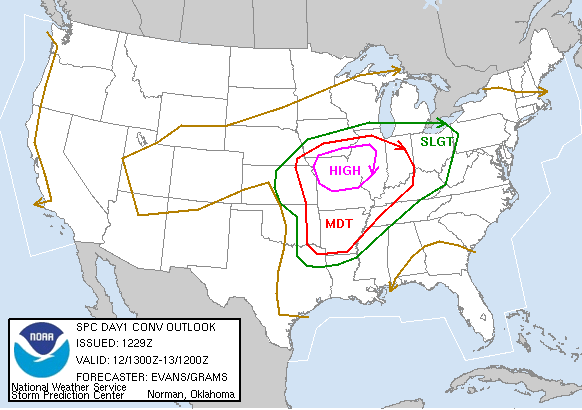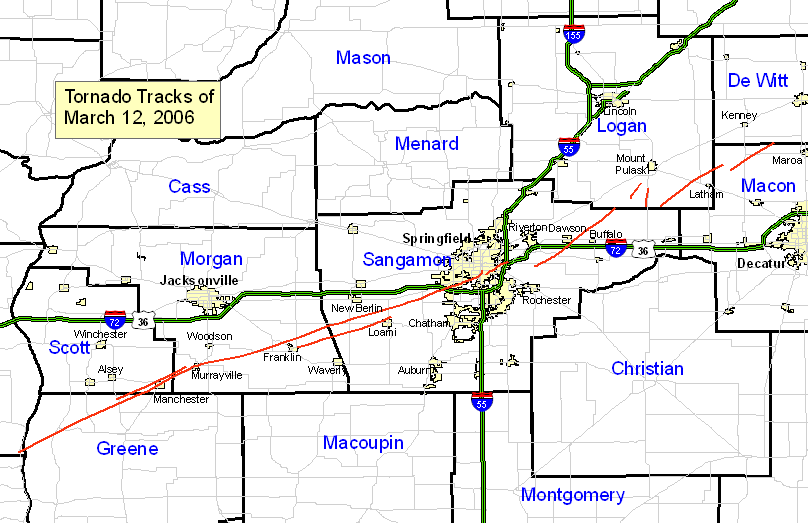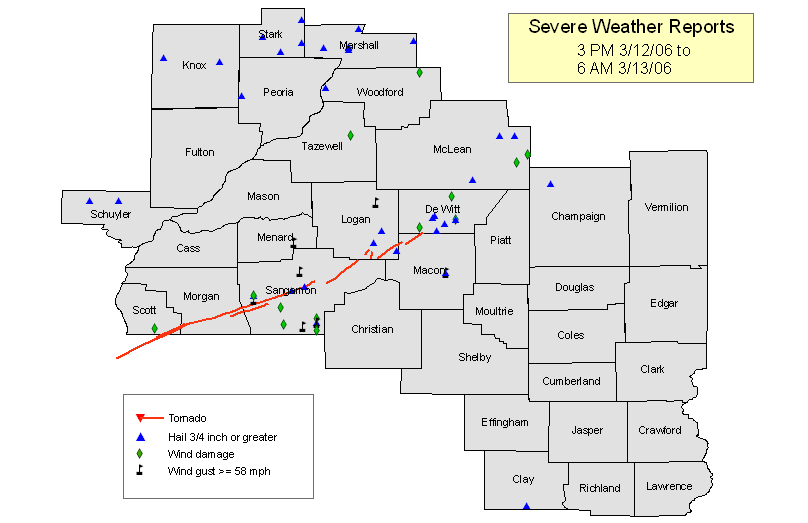|

Severe Weather Outlook for March 12
|

Severe Weather Reports from March 12
|

Tornado Tracks across Central Illinois
|

Local Severe Weather Reports
(text listing)
|
On March 12, 2006, an unusually long-tracked supercell thunderstorm moved across the central United States. It originated in northeast Oklahoma around midday, tracked across Kansas and Missouri during the afternoon and early evening, across Illinois during mid to late evening, and northern Indiana late evening into overnight, before finally dissipating in southern Michigan.
The National Weather Service in Lincoln issued tornado warnings for 24 counties, severe thunderstorm warnings for 27 counties, and 65 severe weather statements during the course of the event. Some of these occurred during thunderstorms which developed during the afternoon, but the vast majority occurred from about 7 PM Sunday to 6 AM Monday.
Analysis and storm surveys indicated 9 tornadoes occurred across the Lincoln county warning area (see area highlighted in the "Local Severe Weather Reports" map above). Several of these attained F2 intensity on the Fujita Scale. One of the tornadoes, which was the first one to affect Springfield, had a track of approximately 66 miles.
The 9 tornadoes are as follows (click on a link for more specific information:
- Tornado 1: Southeast corner of Pike County to Springfield (Sangamon County). Click here for more specific information on Springfield.
- Tornado 2: Springfield (Sangamon County)
- Tornado 3: Franklin (Morgan County) to Loami (Sangamon County)
- Tornado 4: Between Riverton and Rochester (Sangamon County) to the Logan County line
- Tornado 5: Southeast of Lake Fork (Logan County)
- Tornado 6: Sangamon/Logan County line to about 3 miles south of Mt. Pulaski
- Tornado 7: Barrow (Scott County) to Murrayville (Morgan County)
- Tornado 8: Southwest of Latham (Logan County) to northwest corner of Macon County
- Tornado 9: Northwest Macon and far southern De Witt Counties
In addition to these tornadoes, strong straight-line damaging winds were produced in other areas:
- Wind damage was found in southeast Logan County, was found from 1 mile southeast to 2 miles east of Cornland. This damage occurred to farm buildings and trees, and occurred around 8:51 PM.
- In southeast McLean County, wind damage occurred in Saybrook. Survey results suggest that a small microburst hit the town, damaging a Morton-type building west of town, and damaging numerous trees in town. One older building was blown down. Damage was about 5 blocks wide, with estimated wind speeds around 70 mph. The damage was produced by a line of thunderstorms, that moved through the area around 3:38 AM Monday, March 13. Also, about 4 miles north of Saybrook, another Morton-type building was totally destroyed by straight line damaging winds. This damage was caused by the evening supercell, around 9:23 PM.
We also have links to an overview of radar and other weather observations during the event.
